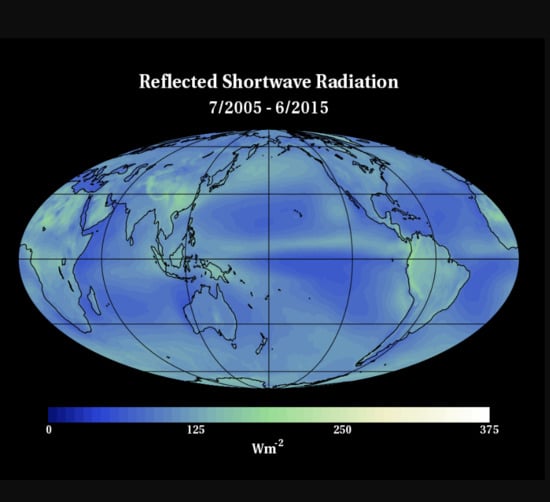CERES Energy Balanced and Filled (EBAF) from Afternoon-Only Satellite Orbits
Abstract
1. Introduction
2. EBAF SW Empirical Diurnal Correction
2.1. Methodology
2.2. Diurnal Correction after Terra and Aqua Start to Drift in MLT
3. Validation of Afternoon-Only EBAF Record
3.1. Climatological Mean Differences
3.2. Anomalies
4. Summary and Conclusions
Author Contributions
Funding
Acknowledgments
Conflicts of Interest
References
- Summary for Policymakers. In Climate Change 2013: The Physical Science Basis. Contribution of Working Group I to the Fifth Assessment Report of the Intergovernmental Panel on Climate Change; Stocker, T.F., Qin, D., Plattner, G.K., Tignor, M., Allen, S.K., Boschung, J., Nauels, A., Xia, Y., Bex, V., Midgley, P.M., Eds.; Cambridge University Press: Cambridge, UK; New York, NY, USA, 2013. [Google Scholar]
- Loeb, N.G.; Doelling, D.R.; Wang, H.; Su, W.; Nguyen, C.; Corbett, J.G.; Liang, L.; Mitrescu, C.; Rose, F.G.; Kato, S. Clouds and the Earth’s Radiant Energy System (CERES) Energy Balanced and Filled (EBAF) Top-of-Atmosphere (TOA) Edition-4.0 Data Product. J. Clim. 2018, 31, 895–918. [Google Scholar] [CrossRef]
- Kato, S.; Rose, F.G.; Rutan, D.A.; Thorsen, T.J.; Loeb, N.G.; Doelling, D.R.; Huang, X.; Smith, W.L.; Su, W.; Ham, S.-H. Surface Irradiances of Edition 4.0 Clouds and the Earth’s Radiant Energy System (CERES) Energy Balanced and Filled (EBAF) Data Product. J. Clim. 2018, 31, 4501–4527. [Google Scholar] [CrossRef]
- Doelling, D.R.; Loeb, N.G.; Keyes, D.F.; Nordeen, M.L.; Morstad, D.; Nguyen, C.; Wielicki, B.A.; Young, D.F.; Sun, M. Geostationary Enhanced Temporal Interpolation for CERES Flux Products. J. Atmos. Ocean. Technol. 2013, 30, 1072–1090. [Google Scholar] [CrossRef]
- Johnson, G.C.; Lyman, J.M.; Loeb, N.G. Improving estimates of Earth’s energy imbalance. Nat. Clim. Chang. 2016, 6, 639–640. [Google Scholar] [CrossRef]
- Loeb, N.G.; Manalo-Smith, N.; Kato, S.; Miller, W.F.; Gupta, S.K.; Minnis, P.; Wielicki, B.A. Angular Distribution Models for Top-of-Atmosphere Radiative Flux Estimation from the Clouds and the Earth’s Radiant Energy System Instrument on the Tropical Rainfall Measuring Mission Satellite. Part I: Methodology. J. Appl. Meteorol. 2003, 42, 240–265. [Google Scholar] [CrossRef]
- Su, W.; Corbett, J.; Eitzen, Z.; Liang, L. Next-generation angular distribution models for top-of-atmosphere radiative flux calculation from CERES instruments: Methodology. Atmos. Measure. Tech. 2015, 8, 611–632. [Google Scholar] [CrossRef]
- Doelling, D.R.; Haney, C.; Bhatt, R.; Scarino, B.; Gopalan, A. Geostationary Visible Imager Calibration for the CERES SYN1deg Edition 4 Product. Remote Sens. 2018, 10, 288. [Google Scholar] [CrossRef]
- Loeb, N.G.; Thorsen, T.J.; Norris, J.R.; Wang, H.; Su, W. Changes in Earth’s Energy Budget during and after the “Pause” in Global Warming: An Observational Perspective. Climate 2018, 6, 62. [Google Scholar] [CrossRef]
- Bond, N.A.; Cronin, M.F.; Freeland, H.; Mantua, N. Causes and impacts of the 2014 warm anomaly in the NE Pacific: 2014 WARM ANOMALY IN THE NE PACIFIC. Geophys. Res. Lett. 2015, 42, 3414–3420. [Google Scholar] [CrossRef]
- Loeb, N.G.; Wang, H.; Allan, R.P.; Andrews, T.; Armour, K.C.; Cole, J.N.S.; Dufresne, J.-L.; Gettelman, A.; Guo, H.; Mauritsen, T.; et al. New Generation of Climate Models Track Recent Unprecedented Changes in Earth’s Radiation Budget Observed by CERES. Geophys. Res. Lett. 2019, 47. [Google Scholar] [CrossRef]
- Loeb, N.; Manalo-Smith, N.; Su, W.; Shankar, M.; Thomas, S. CERES Top-of-Atmosphere Earth Radiation Budget Climate Data Record: Accounting for in-Orbit Changes in Instrument Calibration. Remote Sens. 2016, 8, 182. [Google Scholar] [CrossRef]
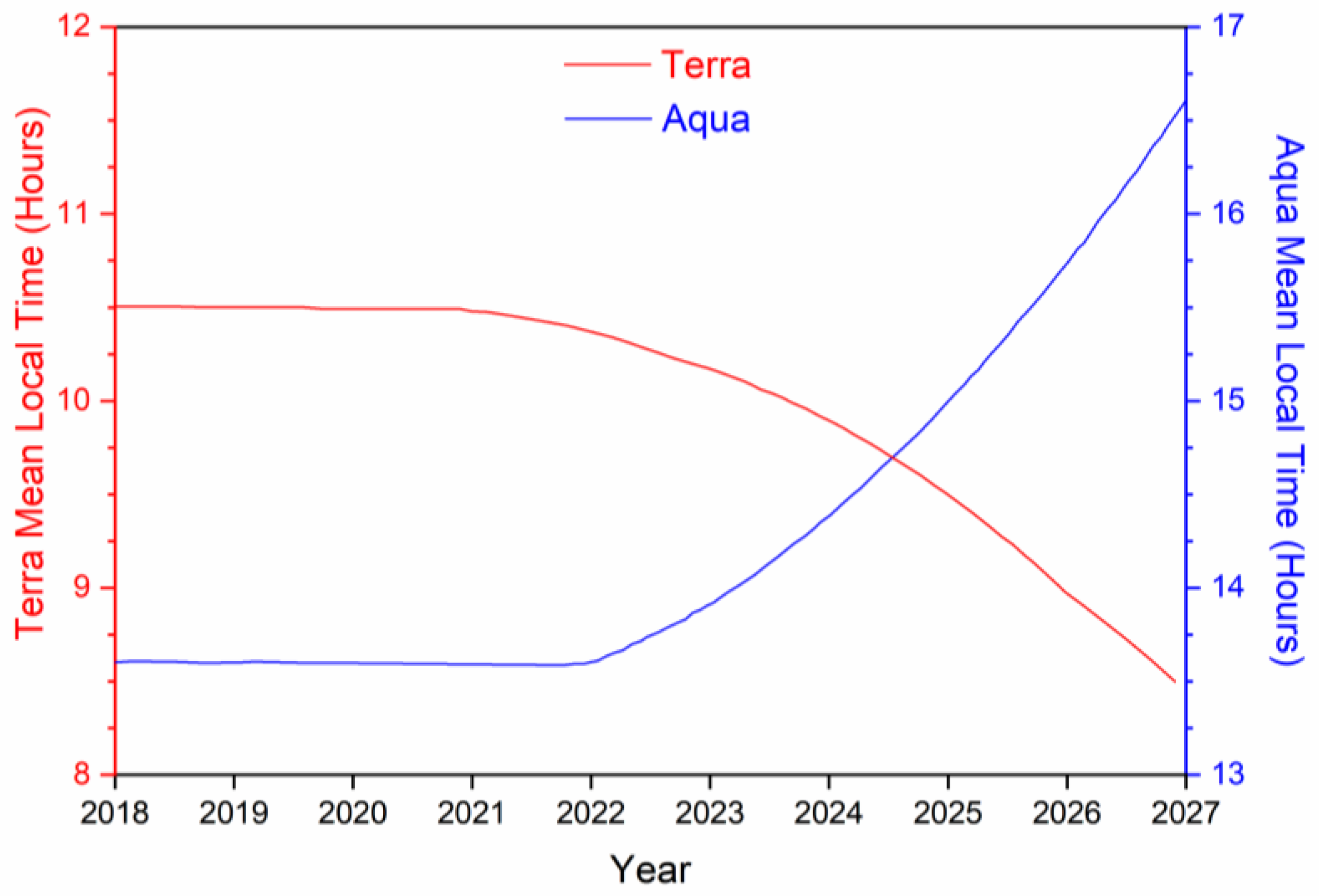
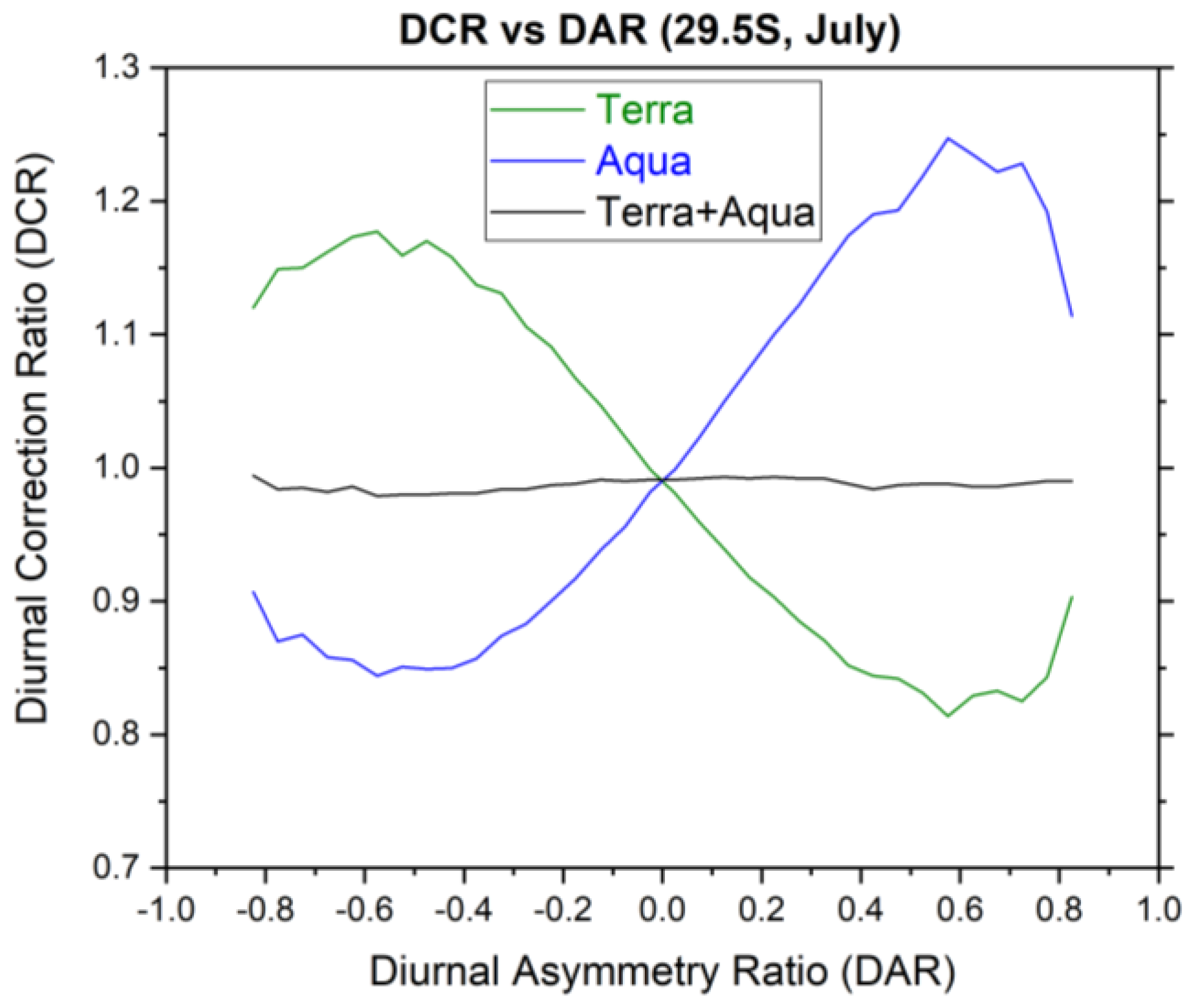


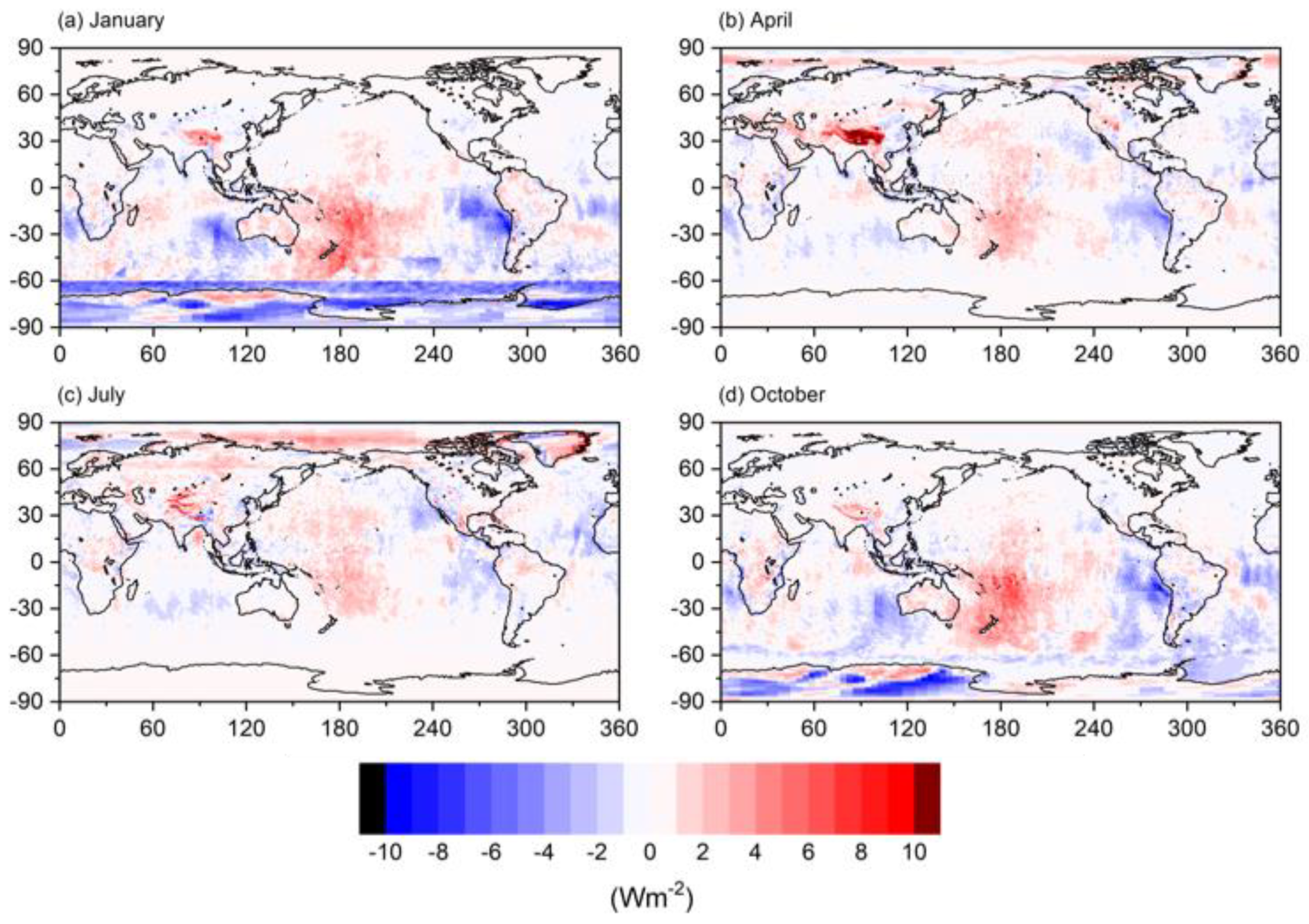

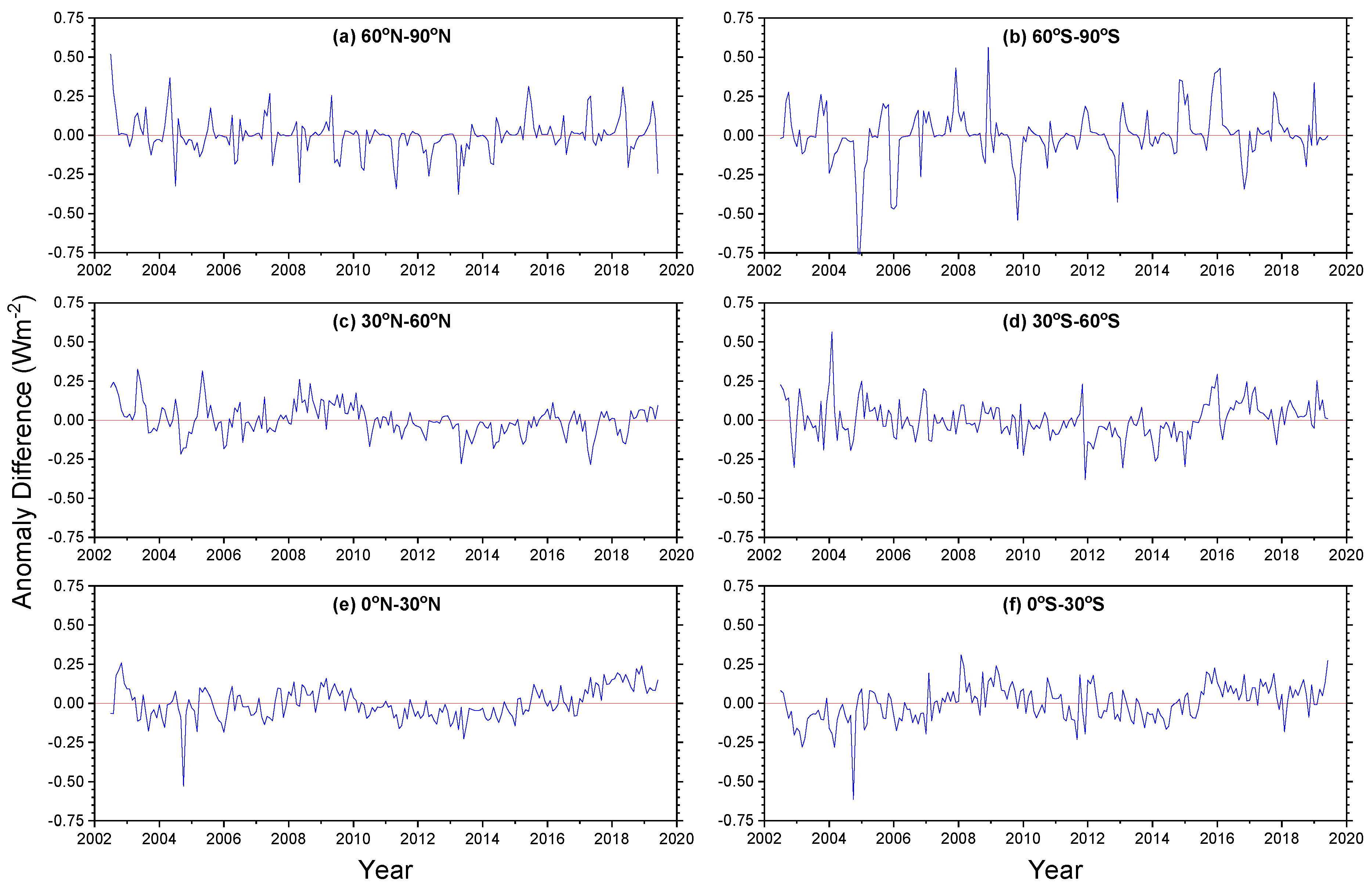

| Domain | Mean | Std Dev |
|---|---|---|
| 60°N–90°N | 0.32 | 0.58 |
| 30°N–60°N | 0.13 | 0.15 |
| 0°–30°N | 0.02 | 0.10 |
| 0°–30°S | 0.05 | 0.12 |
| 30°S–60°S | 0.00 | 0.12 |
| 60°S–90°S | −0.79 | 1.24 |
| Global | 0.01 | 0.13 |
| Standard Deviation (Wm−2) | Explained Variance (%) | Trend (Wm−2 per Decade) | |||
|---|---|---|---|---|---|
| Domain | Ter + Aqu | Aqu − (Ter + Aqu) | Ter + Aqu | Aqu − (Ter + Aqu) | |
| 60°N–90°N | 1.86 | 0.12 | 99.6 | −0.78 ± 0.85 | −0.007 ± 0.047 |
| 30°N–60°N | 1.33 | 0.10 | 99.4 | −0.94 ± 0.40 | −0.054 ± 0.054 |
| 0°–30°N | 1.45 | 0.10 | 99.5 | −0.53 ± 0.62 | 0.048 ± 0.056 |
| 0°–30°S | 1.26 | 0.12 | 99.1 | −0.38 ± 0.46 | 0.085 ± 0.047 |
| 30°S–60°S | 1.00 | 0.12 | 98.6 | −0.48 ± 0.33 | 0.003 ± 0.052 |
| 60°S–90°S | 1.56 | 0.17 | 98.8 | −0.44 ± 0.97 | 0.043 ± 0.085 |
| Global | 0.59 | 0.07 | 98.7 | −0.57 ± 0.20 | 0.026 ± 0.039 |
© 2020 by the authors. Licensee MDPI, Basel, Switzerland. This article is an open access article distributed under the terms and conditions of the Creative Commons Attribution (CC BY) license (http://creativecommons.org/licenses/by/4.0/).
Share and Cite
Loeb, N.G.; Doelling, D.R. CERES Energy Balanced and Filled (EBAF) from Afternoon-Only Satellite Orbits. Remote Sens. 2020, 12, 1280. https://doi.org/10.3390/rs12081280
Loeb NG, Doelling DR. CERES Energy Balanced and Filled (EBAF) from Afternoon-Only Satellite Orbits. Remote Sensing. 2020; 12(8):1280. https://doi.org/10.3390/rs12081280
Chicago/Turabian StyleLoeb, Norman G., and David R. Doelling. 2020. "CERES Energy Balanced and Filled (EBAF) from Afternoon-Only Satellite Orbits" Remote Sensing 12, no. 8: 1280. https://doi.org/10.3390/rs12081280
APA StyleLoeb, N. G., & Doelling, D. R. (2020). CERES Energy Balanced and Filled (EBAF) from Afternoon-Only Satellite Orbits. Remote Sensing, 12(8), 1280. https://doi.org/10.3390/rs12081280



